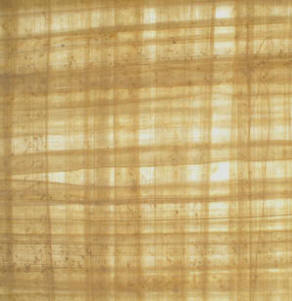What is papyrus ?
Cyperus papyrus is a long stemmed plant that grows in damp regions of the Nile Delta
in Egypt. Ancient Egyptians discovered how to make paper from the stems of
plant as early as 3000 B.C. Egyptian papyrus was used as we use paper today.
Buy papyrus

Cyperus papyrus plant |

Genuine Blank papyrus paper
Buy |
History of Papyrus
Egyptians used papyrus reeds to make boats, they burned the roots for fuel,
and from dried papyrus they made mats, mattresses, baskets, boxes, tables and
sandals. Papyrus was even used as a source of food for the common people but
Egypt's greatest achievement in the ancient world was turning papyrus sheet to
paper.
Papyrus sheets were the preferred writing materials of the ancient world
because they were light, strong, thin, durable, and easy to carry. Thus, papyrus
sheets share many of the advantages of modern paper.
Because of its importance, papyrus paper making was a state monopoly in Egypt
and the method of its production was a closely guarded secret. Many efforts were
made in various parts of the Mediterranean to find local substitute for papyrus
sheets thus we find that clay and wax tables, lead sheets and parchment were all
used as writing materials by different peoples. However, all these materials
proved to be inferior, in one respect or another, to papyrus, which remained the
primary writing material in Egypt.
In the 10th century Arabs introduced the pulped paper process, which they had
learned from their Chinese prisoners. Though the pulped paper was less durable
than papyrus, the process was considerably easier and far less expensive than
papyrus sheet making. As a result of the imported technology, Egyptians
gradually abandoned the production of papyrus paper and neglected the
cultivation of papyrus plantations. A few centuries later papyrus paper had
completely disappeared from the Egyptian panorama.
In 1960, nearly a thousand years later Dr. Hassan Ragab (Former Ambassador)
set out to rediscover this lost art. Two formidable obstacles had to be
overcome: First, strange as it may seem, though papyrus is typically an Egyptian
plant, it had completely vanished from Egypt due to lack of cultivation and
heavy silting in the marshes, lakes and ponds where it used to grow. To
re-establish the papyrus plant in Egypt, Dr. Ragab journeyed to Sudan to obtain
roots of the Cyprus papyrus. These roots were used to establish his papyrus
plantation at Jacob Island at Giza near Cairo, and it considered the largest man
made papyrus plantation in the world. The second major obstacle was
rediscovering the process by which papyrus sheets could be produced. It is
amazing that the ancient Egyptians, who left records about all aspects of their
daily life and thousands of papyri in their tombs, did not leave a single word
or drawing about papyrus papermaking. Dr. Ragab spent three years trying to
solve this problem before his research was crowned with success, and papyrus
sheet making was once again an inherent part of Egyptian culture. As the papyrus
paper making was a state monopoly during the ancient Egyptian time, it was a
Ragab's family monopoly for long time. Dr. Ragab registered papyrus paper
making. Thanks to Dr. Ragab and his family papyrus paper making became one of
the most important tourism industries in Egypt. Now the second and third
generations of Ragab's family are still working in making papyrus.
How papyrus is made?
To make papyrus paper the inner pith of the
stem is cut lengthways into strips and soaked in water. The strips are
then placed side by side with a second layer placed at right angles to the
first. The two layers are then beaten with a mallet to break down the
fibers and bond the strips together. The sheets are left to dry under
weights for several days. The dried sheets are polished with a flat stone
to make them smooth and ready for use.
What types of paint are used to paint on papyrus?
Nearly all kinds of colors can be used to paint on papyrus but the most
widely used are Oil paint, Gouache and Water colors.
Where can I buy papyrus artworks?
Almost all Egyptian souvenir shops sell papyrus artworks. You can even buy
online without traveling to Egypt. We have a large collection of papyrus
paintings and if you need a special painting you can contact us to help you find
it.
 |
 |
 |
 |
Click here to buy papyrus online
|
| Cleopatra painting on papyrus |
King
Tutankhamun and his wife painted on papyrus |
Crowning papyrus painting |
Papyrus
painting of Tutankhamun Mask |
|
Tips on buying papyrus paintings: Not all papyrus paintings
are of the same quality, you might have heard of banana leaves, which
can be made to look like papyrus but it's lower in quality than genuine
papyrus.You can recognize the papyrus quality by certain factors:
- Genuine papyrus is a bit heavier and somewhat opaque
- High quality papyrus is hard to tear
- When you roll a papyrus paper it tends to go back to its
original shape
- Check that papyrus artwork is painted by hand not printed
- Papyrus comes in dark and light color , dark or brown papyrus
takes longer to make.
|